
|
Cleared for Landing
Summary: To accommodate a 13.25 ton portion of a Boeing 747 fuselage, the National Air and Space Museum in Washington, D.C, made rare structural reinforcements to the building, installing columns that reached through the basement that support the freestanding fuselage and the pedestrian bridge that brings visitors to it. The fuselage is part of the museum’s new permanent exhibit, America by Air, which showcases the history of the commercial airline industry. The Smithsonian’s National Air and Space Museum has been retrofitted for a smooth landing for the most prolific passenger jet model of the Modern age. As part of its exhibit documenting the history of air travel, the museum has brought in a 26,500-pound cockpit section of a Boeing 747. This new permanent exhibit has been in the making for eight years and involved the work of a large team of architects, engineers, and contractors to make it happen. In 1999 Northwest Airlines donated to the museum’s curator, Robert van der Linden, a Boeing 747 (built in 1970) they were retiring. With no room for the entire 231-foot airplane, van der Linden suggested cutting off and displaying only the front fuselage of the airplane. Mid-2006, in North Carolina, Northwest cut the cockpit section into 11 pieces and shipped them to Washington, D.C. (The first piece didn’t arrive till January of 2007.) The Smithsonian team carefully ushered them all into the museum with the aid of the massive hangar bay doors on the west side of the building. The mammoth cockpit section required that the floor be permanently reinforced before it could be displayed in the Gyo Obata-designed expansive glass cubed atrium, a rarity for a museum where most exhibits are hung and supported by ceiling beams, according to David Paper, chief of the Exhibit Production Division, and Frank Florentine, project manager. To properly support the fuselage, they had a concrete column installed that runs from the front landing gear, through the floor, to the basement of the museum. Paper says this is the first time this type of structural reinforcement has been done at the museum.
With the aid of several cranes (which required temporary shoring themselves) the airplane and the support structure were reassembled and will be ready for public viewing by November 17, when the exhibit opens. Huge and complex All renovation work was done while the museum was still in operation, with rigging and installation taking place after hours. The 747 dominates the gallery hall it’s placed in, a giant among giants even in its amputated form. It’s one of the largest pieces the museum has ever accommodated, and both Paper and Florentine say it was the most logistically complicated project they have worked on.
“Everything you ever wanted to know about air travel will be covered in this exhibit,” says Museum Director Jim Dailey. “ reminds us how no other machine but the airliner put the far corners of the world within the reach of so many. It’s impossible to imagine modern life without it, and it’s hard not to relate instantly to this new gallery.” |
||
Copyright 2007 The American Institute of Architects. All rights reserved. Home Page |
||
news headlines
practice
business
design
The floor plan indicates how much space a 747 would take up if the entire plane were on exhibit.




